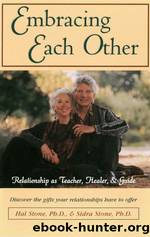Embracing Each Other by Hal Stone Phd

Author:Hal Stone, Phd
Language: eng
Format: epub
ISBN: 9781608681266
Publisher: New World Library
5
More about Bonding Patterns
Further Exploration of Bonding Patterns
In our last chapter, we discussed the general issue of bonding patterns in primary relationship. In this chapter we will be continuing our discussion, with special emphasis on the role of primary and disowned selves. We will see how bonding patterns operate in family systems and how our disowned selves make us available to bonding patterns in a variety of other relationships. We will also include a brief discussion of transference as a specific type of bonding pattern. First, however, we would like to review some general principles in the consideration of bonding patterns.
It is very important that we treat bonding patterns as normal and natural phenomena. Bonding patterns are not indicative of pathology. They are operating in all relationships all the time. They often create powerful feelings of intimacy and closeness between people. The disowned selves provide the keys to understanding the bonding patterns.
Many couples spend their lives in relationships that are quite totally parent/child in nature and there is very little personal growth over an entire lifetime. Yet they lead good and happy lives without any concern about personal development. Each carries the otherâs disowned selves with comfort, and the bonding pattern does not become overtly negative.
For ever increasing numbers of people, however, this form of relationship no longer works. One of the reasons that so many marriages fail is that the comfort and the concomitant psychological constriction of positive bonding patterns creates boredom and, as time passes, this constriction works to destroy the dynamic life of a marriage.
For people who become concerned with life in a new way, for people who become involved with issues of change and growth, a new kind of relationship is necessary. Once this happens, the understanding of issues of bonding becomes essential. It becomes apparent that when one takes the discomforts of personal relationship as an opportunity for personal growth, the difficulties themselves become an opportunity for a new kind of process, one we might call mutual self-exploration or the mutual evolution of consciousness.
In the last chapter, our considerations applied to all relationships, whether they were male/male, female/female, or female/male. Now we begin to examine bonding patterns in families with children. We do not consider this a comprehensive treatise on family bondings. Rather, we wish simply to give you a feeling of how the bonding patterns in couples are affected by their families of origin, by the addition of children, and, also, to illustrate some of the kinds of bonding patterns that develop between children and parents.
The perpetuation of bonding patterns across generations is a fascinating study in its own right. One re-creates oneâs childhood bonding patterns repeatedly until, with the expansion of oneâs awareness, there is some possibility of choice entering into the system and the opportunity to use the bonding experiences to heal past wounds and to guide one in oneâs own growth process. This is illustrated by the bonding pattern of Marilyn and Jack.
Download
This site does not store any files on its server. We only index and link to content provided by other sites. Please contact the content providers to delete copyright contents if any and email us, we'll remove relevant links or contents immediately.
| Codependency | Conflict Management |
| Dating | Divorce |
| Friendship | Interpersonal Relations |
| Love & Loss | Love & Romance |
| Marriage | Mate Seeking |
The 5 Love Languages: The Secret to Love That Lasts by Gary Chapman(9506)
Doing It: Let's Talk About Sex... by Hannah Witton(9148)
Should I Stay or Should I Go? by Ramani Durvasula(7515)
The Road Less Traveled by M. Scott Peck(7469)
The Lost Art of Listening by Michael P. Nichols(7356)
Daring Greatly by Brene Brown(6364)
Beartown by Fredrik Backman(5542)
We Need to Talk by Celeste Headlee(5493)
Men In Love by Nancy Friday(5110)
The Rules Do Not Apply by Ariel Levy(4786)
The State of Affairs by Esther Perel(4586)
How To Win Friends and Influence People by Dale Carnegie(4400)
Reflections Of A Man by Mr. Amari Soul(4205)
Pillow Thoughts by Courtney Peppernell(4170)
The Ethical Slut by Janet W. Hardy(4145)
Algedonic by r.h. Sin(3979)
He's Just Not That Into You by Greg Behrendt & Liz Tuccillo(3802)
I Love You But I Don't Trust You by Mira Kirshenbaum(3773)
Finding My Forever by Heidi McLaughlin(3728)
